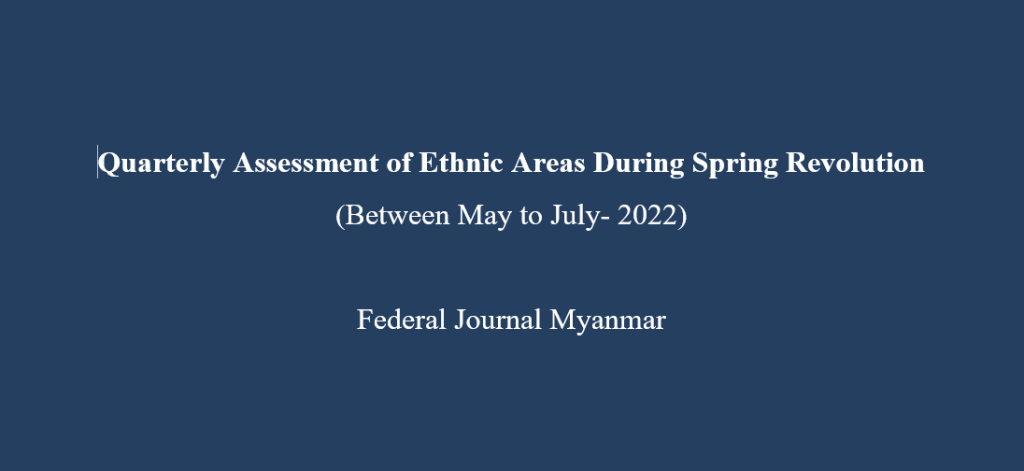Quarterly Assessment of Ethnic Areas During Spring Revolution
(Between May to July- 2022)
The Federal Journal publishes a quarterly report about public activities and movements to eliminate the era of the military junta in the Spring revolution in Myanmar. This report will disclose about casualties due to conflict incidents, destruction of civilian structures due to the Junta’s operation, displacement and political coordination and consultative bodies in ethnic areas between May to July 2022.
Part (I)
The situation of Conflict and Security in Ethnic Areas (Armed Clashes, Destruction of Civilian Properties, Displacements, Casualties and Injuries)
As the following table shows that 1516 clashes were observed between the Junta’s forces and resistance forces in ethnic states areas within the three months period from May to July which left 1210 wounded and 2329 died from the side of the Junta forces; 155 in Kachin, 299 in Karenni, 471 in Chin, 1099 in Karen, 150 in Mon, 155 in Shan respectively.
From the side of resistant groups, 147 members were also dead in those conflict incidents. The number of displaced populations in ethnic areas has reached about 436,198 excluding Rakhine state by the end of July.
The states where the highest number of displaced people are seen in Karenni with 202,115, Karen with 105,650 and Chin with 68,933 respectively.
In addition, due to the shelling of the Junta’s forces in civilian areas, at least 173 civilian casualties have been observed in the last three months in ethnic areas: 27 in Kachin, 15 in Karenni, 55 in Chin, 25 in Karen, 24 in Mon and 27 in Shan respectively.
Note. Rakhine state is not included in the list as there are no significant clashes in the reporting period.
Part (II)
Ethnic/States Coordination Bodies
(1) Pa Oo National Federal Council (PNFC)
A brief policy of Pa-O National Federal Council (PNFC) has been released which was approved by PaO National Conference. According to Khun Way Htoo, a spokesperson of PNFC said that the Council is comprised of 15 members, three representatives each from five organizations; PaO National Liberation Organization (PNLO), Diaspora Forces, Internal Strike groups and Unions, PaO Political Consultative Council – PPCC and PaO People Defense Force – Kham Dom- PPDF.
(2) Kachin Political Interim Coordination Team (KPICT)
Salang Nsang Gum San, a Secretary of KPICT attended a meeting of UN Security Council Members along with representatives of ethnic armed groups from Myanmar on May 25, 2022. The most important discussion points during that meeting were to impose sanctions against Myanmar’s Oil and Gas Enterprise which is a major source of income for the military junta, a possible meeting between the UN security council and Ethnic Revolution Organizations and humanitarian aid in conflict-affected areas. At present, it is learnt that KPICT has withdrawn its membership in National Unity Consultative Council (NUCC). Education services for youths have been planned in the KIA control areas (Liberated Areas) with the cooperation of the Education Department of KIO, education committees under KPICT, Kachin University Coordination Committee which is formed by CDM teachers.
(3) Karenni State Consultative Council (KSCC)
It is observed that Karenni state Consultative Council (KSCC) starts giving education and health care service to people in the areas by forming Federal education and health committees. For example, KSCC has been providing educational services by cooperating with Free Online Educational Institution Myanmar – FOEIM. Moreover, KSCC has been working to give healthcare services to IDPs and some villages through the cooperation with JCC-Health of NUCC and some private health teams or organizations.
(4) Interim Chin National Consultative Council (ICNCC)
It is learnt that ICNCC has been working with some Local Public Administration Teams and some departments of NUG which has resulted from some support in education and some other sectors. Likewise, it is observed that the ICNCC is also raising funds for Chin’s revolutionary movement through the project NUG Bond for Chin. Moreover, it is learnt that the ICNCC discussed with the Chinland Joint Defense Committee (CJDC) the formation of the Chinland Administration and Interim Chinland Government, and negotiated for drafting the Chinland Charter/Constitution.
(5) Mon state Interim Coordination Committee (MSICC)
Mon State Interim Coordination Committee (MSICC) and Alliance Relation Committee of the National Unity Government met two times on June 19 and July 6, 2022. The meeting reviewed their joint activities of them and agreed on possible coordination between them in the sectors such as public services, humanitarian assistance and so on.
References –
- Direct interviews by the Federal Journal Myanmar Team
- Ethnic-Based News Medias
- Ethnic Human Right Organizations
- Ministry of Defense, NUG
- ISP Myanmar
- Officials of Interim Consultative Councils (MSICC, KSCC, KPICT, ICNCC, PNFC, CSSU)
- Exclusive Interviews by Federal Journal Myanmar
- Burma Human Rights Network
- Data for Myanmar
- Assistance Association for Political Prisoners (Burma)
—000—

